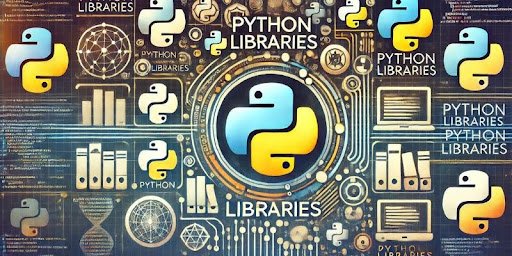Machine learning has revolutionized various industries, from healthcare and finance to marketing and automation. Python is the most popular programming language for AI and data science, and developers and researchers rely on its extensive libraries to streamline their machine-learning projects. Understanding the right tools can significantly enhance your workflow, whether you are a beginner or an experienced professional. This article will explore ten essential Python libraries that machine-learning enthusiasts should know.
Why Learning Python for Machine Learning is Crucial
Machine learning is evolving rapidly, and having proficiency in Python is essential for staying ahead in the industry. Understanding the capabilities of these libraries enables developers to build scalable, efficient, and high-performing models. Enrolling in a structured learning program like Python Training in Chennai can provide hands-on experience and expert guidance to master these libraries and apply them effectively in real-world projects.
1. NumPy: The Foundation of Scientific Computing
NumPy (Numerical Python) is one of Python’s fundamental libraries for numerical computing. It supports large multidimensional arrays and matrices and a collection of mathematical functions to operate on these data structures. Machine learning algorithms rely on efficient computation, and NumPy offers optimized operations that boost performance. Additionally, many other libraries, like TensorFlow and Scikit-learn, use NumPy as a backend for handling arrays.
2. Pandas: Data Manipulation Made Easy
Pandas is a powerhouse for data manipulation and analysis. It provides flexible data structures, primarily DataFrames and Series, allowing easy structured data handling. Whether you’re cleaning raw datasets, performing exploratory data analysis (EDA), or preparing data for machine learning models, Pandas simplifies the entire process. Its intuitive syntax enables fast data filtering, merging, reshaping, and aggregation, making it indispensable for any machine-learning workflow.
3. Matplotlib: Data Visualization for Insights
Data visualization is crucial to understanding data patterns and model performance in machine learning. Matplotlib is a widely used library for creating static, animated, and interactive visualizations in Python. It helps generate line plots, bar charts, histograms, scatter plots, and more. When combined with Pandas and Seaborn, Matplotlib enhances data storytelling and assists in making informed decisions based on visual insights.
4. Seaborn: Statistical Data Visualization
While Matplotlib provides extensive visualization capabilities, Seaborn simplifies statistical plotting with a high-level interface. It integrates well with Pandas and provides aesthetically appealing and informative charts such as heatmaps, violin, and pair plots. Seaborn’s ability to visualize complex relationships within datasets makes it an essential tool for analyzing patterns before applying machine learning models.
5. Scikit-learn: The All-in-One Machine Learning Library
Scikit-learn is the go-to library for machine learning in Python. It offers a comprehensive suite of algorithms for classification, regression, clustering, dimensionality reduction, and model evaluation. From simple linear regression to advanced ensemble methods like Random Forest and Gradient Boosting, Scikit-learn provides a user-friendly API that enables rapid prototyping and deployment of machine learning models.
6. TensorFlow: Powering Deep Learning Applications
Developed by Google Brain, TensorFlow is a powerful open-source library for deep learning and artificial intelligence. It provides a flexible architecture for building and training complex neural networks. TensorFlow supports distributed computing, enabling large-scale machine learning applications. With TensorFlow’s high-level API, Keras, developers can efficiently create and train models for tasks like image recognition, natural language processing (NLP), and reinforcement learning.
7. Keras: Simplifying Neural Networks
Keras is a high-level neural networks API built on top of TensorFlow. It offers a user-friendly interface for designing and training deep learning models with minimal code. Keras provides pre-trained models, simplifying transfer learning and enabling developers to fine-tune existing architectures for various applications. Due to its ease of use and flexibility, Keras is widely preferred by beginners and experts.
8. PyTorch: Dynamic Computation for Deep Learning
PyTorch, developed by Facebook’s AI Research lab, is another popular deep learning framework known for its dynamic computation graph. Unlike TensorFlow, which uses static graphs, PyTorch allows model changes on the fly, making it highly flexible for research and experimentation. It provides automatic differentiation, GPU acceleration, and an intuitive debugging experience. PyTorch’s popularity in academia and industry is skyrocketing due to its efficiency and ease of use.
9. XGBoost: The Ultimate Gradient Boosting Library
XGBoost (Extreme Gradient Boosting) is a high-performance library for gradient boosting, widely used in competitive machine learning challenges. Known for its speed and accuracy, XGBoost efficiently handles large datasets, missing values, and imbalanced data. It supports parallel processing, regularization techniques, and built-in cross-validation, making it a preferred choice for structured data problems such as fraud detection and recommendation systems.
10. LightGBM: Fast and Efficient Gradient Boosting
LightGBM (Light Gradient Boosting Machine) is an optimized version of gradient boosting designed for efficiency and speed. It is particularly effective for large datasets and complex machine-learning tasks. LightGBM’s unique approach to handling categorical variables and reducing memory usage makes it one of the most preferred libraries for tabular data classification and regression problems.
Choosing the Right Library for Your Machine Learning Projects
With a wide array of Python libraries available, selecting the right ones depends on the nature of your machine-learning tasks. If you’re working with traditional machine learning models, Scikit-learn is the best starting point. TensorFlow and PyTorch offer powerful tools for deep learning to build sophisticated models. Meanwhile, XGBoost and LightGBM are indispensable for structured data competitions and real-world applications.
Python’s ecosystem of machine learning libraries makes it an excellent choice for developing AI applications. Whether you’re a beginner exploring the fundamentals or an experienced professional optimizing advanced models, leveraging the right tools can make all the difference. By mastering essential libraries like NumPy, Pandas, Scikit-learn, TensorFlow, and PyTorch, you can enhance your skills and contribute to innovative solutions in the ever-growing field of machine learning.



